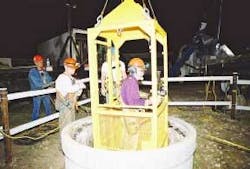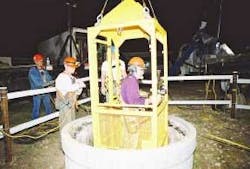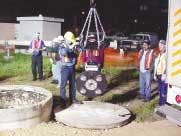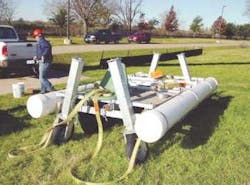Innovative Tunnel Inspection Buys Certainty
By Clint Walker and Randy Pohren
Corrosion was already eating away at one of Austin's largest and most critical infrastructure components. To avert the possibility of a catastrophic failure of the massive Govalle wastewater tunnel, since the extent of corrosion was unknown, the city decided that a manned inspection of the tunnel – running over 100 feet below city streets — would provide critical information on the structure's actual condition. But with the only access to the "live" tunnel through widely separated access shafts, and distances too great for conventional inspection methods, the engineers developed an innovative program to conduct the complex inspection process.
Background
The Govalle Tunnel, an 8-mile-long, 8-ft.-diameter concrete pipeline, was built in 1988 to convey wastewater from central and downtown Austin, TX, to the South Austin Regional Wastewater Treatment Plant. There is no direct access to the tunnel, which is an average depth of 100 ft. below the ground surface; instead, at only five sites, a drop shaft and an adjacent access shaft connect to a lateral through which wastewater enters the tunnel.
In 1996, high levels of hydrogen sulfide (H2S) gas were detected at the laterals, creating significant odors and representing a potential for corrosion of the concrete tunnel. Significant corrosion was observed in the shafts with the covers removed. Recognizing that a failure of the tunnel could have catastrophic environmental consequences – there was no way to stop or divert wastewater flow — the city decided to investigate the condition of the entire tunnel and hired the environmental engineering and consulting firm Malcolm Pirnie to conduct the investigation.
Based on the initial study requirements outlined by the state environmental regulatory agency, the firm recommended installing odor control facilities at four sites; these facilities were constructed in 2000. Malcolm Pirnie also initially recommended the construction of new tunnel access structures to facilitate inspection to shorten the distance between access points in the tunnel — at an estimated cost of $500,000 each, these would have cost the city over $2 million. However, cost, overall constructability, and land acquisition issues kept the new access shafts from being constructed. Instead, the engineers and the city decided to reevaluate where the project was headed in light of newly available state-of-the-art inspection equipment and technologies.
New Technology Provides Solution
At a "Stop" meeting in 2001 with representatives from engineering, construction, and inspection technology firms nationwide, Malcolm Pirnie and the city recognized that the distances between shafts (as much as 17,000 feet) were too great to drag conventional video equipment and cables through the "live" tunnel with active wastewater flow. However, recent advances in fiber optic and other technology had created opportunities to span the required distances and maintain safety of inspectors.
At the same time, significant concern was raised about the structural safety of entry to the tunnel, since surface observations at drop shafts had revealed considerable corrosion, apparently caused by high concentrations of hydrogen sulfide gas.
Based on these considerations and information developed in the Stop meeting, it was determined that manned inspection was feasible and would provide the best information about the condition of the tunnel. Malcolm Pirnie prepared a new inspection plan that included preliminary inspection followed by final inspection. The preliminary inspection provided data on the structural integrity and general condition of the tunnel's access shafts and laterals for the final inspection contractor.
An innovative video technology, the Aqua Zoom™ camera (by InfraMetrix, Wakefield, MA), a stationary camera with specialized lights and zooming capabilities, was used. Following verification by the Aqua Zoom camera that the general conditions were safe, core samples were also collected by lowering a man at the top, middle and bottom of each access shaft on each service lateral for laboratory analysis. At a total cost of less than $50,000, the preliminary inspection demonstrated sufficient structural integrity of the shafts and provided information to prospective bidders that no special safety measures would be needed – with an estimated savings to the city of more than a quarter of a million dollars to enter the access shaft.
Manned Inspection
Final inspection was conducted by an inspection contractor bid using plans and specifications prepared by Malcolm Pirnie. J.F. White Construction Company was awarded the inspection contract and chose to perform the work in two separate stages, with the total cost of inspection bid was $2,945,000. Stage I consisted of manned inspection of the shafts and laterals at the five locations; an inspector equipped with direct audio communication and fiber optic video recorder was lowered into each shaft using a basket support system and crane. Concrete core samples were taken throughout the shafts and laterals to assess the structural integrity, as requested by the Malcolm Pirnie engineer.
Stage II was the manned inspection of the tunnel reaches – the first time such inspection was ever conducted in an active wastewater tunnel. A special inspection pontoon was constructed by the contractor to carry two inspectors, lighting, tools, video and audio equipment and supplemental air supplies. During each inspection the pontoon was pulled upstream to the next lateral using a winch located in the lateral; fiber-optic cable was also pulled through to allow real-time video and audio of the inspection. Video and audio communications were maintained continuously between inspectors, above-ground crews and the engineer.
The inspection was completed on schedule and under budget, and its objectives met and even exceeded. The resulting photos, videos and physical tests dramatically demonstrate the actual condition of the shafts, laterals and the tunnel itself, showing the nature, extent and the exact location of corrosion that will require future attention.
Completed with a perfect safety record, the required information was collected and will provide the documentation needed for the design of eventual rehabilitations. In the end, the city obtained certainty over the condition of the tunnel, its continued service and the exact repairs that must be made to ensure a long and successful life.
About the Authors:
Clint Walker, P.E., is a Vice President in the Austin office of national environmental engineering and consulting firm Malcolm Pirnie, Inc. With more than 19 years of experience in the water industry, he specializes in the planning, design and construction of water, wastewater and recycled water projects throughout the Southwestern United States. L.R. "Randy" Pohren, P.E., was the Lead Project Engineer for the City of Austin. He currently serves in the Facility Engineering Division of the Austin Water Utility. He has over 25 years of experience in the design and construction of major wastewater process and treatment facilities.



